Every horse has their strengths and weaknesses, and on April 17, in the second day of Sinead Halpin’s clinic in Lexington, Ky., there were a wide variety of both on display.
Nervous horses, bold horses, green horses, schoolmasters looking to up their game—the same principles helped everyone, and Halpin helped apply them in different ways to fit the different horse and rider combos.
You can read all about Day 1 of the clinic in “Footwork, Volume Of The Aids And Bending Lines: Takeaways From A Sinead Halpin Clinic Day 1.”
Laura Werner and High Hopes: Handling the heavy, nervous horse
Werner took a private dressage lesson with Halpin in the morning, and began the session by explaining to Halpin that her horse, High Hopes, tended to be a bit of a nervous nelly. When Werner started working him around the ring, you could see exactly what she meant—the beautiful black horse wanted to lean on the bit heavily for support, and his canter was short and quick.
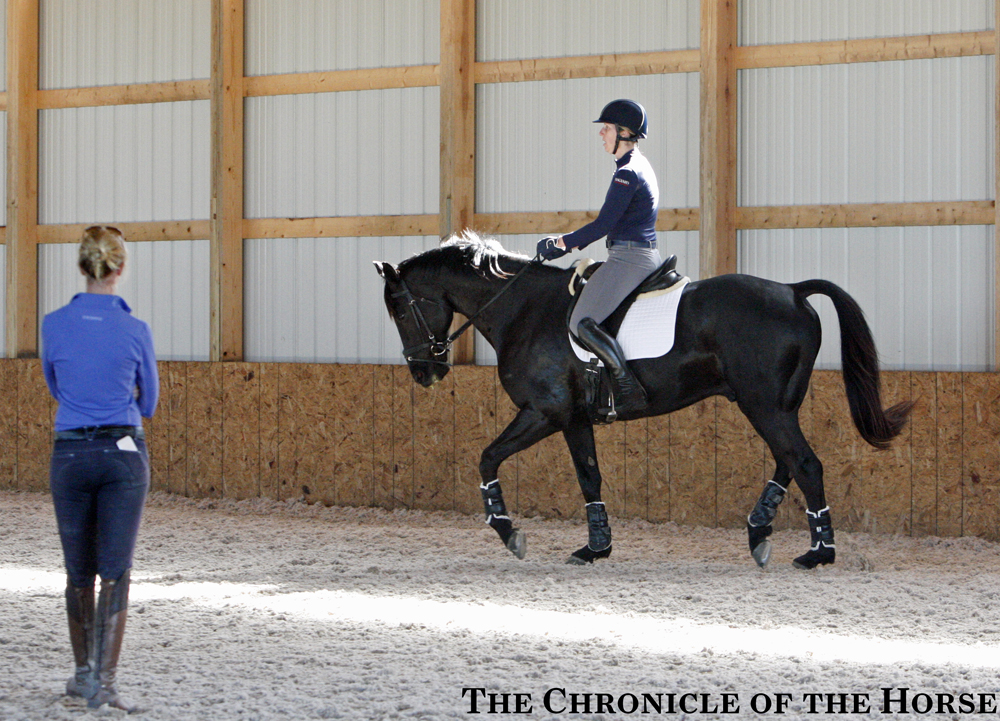
Laura Werner on High Hopes.
After working with Werner a bit from the ground and observing High Hopes’ canter, Halpin asked if she could get a leg up on him. Halpin proceeded to work around the ring at the walk, trot and eventually canter for nearly 20 minutes, very rarely setting foot on the rail for longer than a few strides. She had High Hopes snaking this way and that all over the ring.
Check out the video clip to see some of the ride for yourself!
“I just felt like he is a really sweet horse, and he’s confused by what the contact means,” Halpin explained after her ride (she was silent for the entirety of the 20-minute flat session—one spectator aptly said “it was like church.”)
“You take the reins and he just kind of does this,” Halpin said, clenching her jaw and straining her neck forward in her best impression of a lock-jawed horse. “He isn’t quite sure what he’s supposed to do—he feels like it’s a pressure that he has to cope with, and so he moves his body and gets really crooked and tries to contort his body in way to release pressure, instead of correctly coming through his back and realizing that this contact is there to help. [The contact is] there either to change direction, slow down, or push him rounder.”
Halpin did a series of serpentines up and down the ring, but not going all the way out to the rail—the moment she got the feeling she was looking for from High Hopes, she switched direction.
“All I tried to do was simplify the contact, and every time I touched the reins it was telling him to literally do something that I could reward him for, not just going in a straight line and pulling, pulling,” Halpin explained. “I was taking him and turning him right and as soon as he would turn right I would give him the reins; let’s go right, let’s go left, let’s go right. Every time he answered that question, I gave him the reins, so he realized ‘Oh this is actually a dialogue, it’s a conversation, it’s not just someone pulling on my face.
“Once he started to realize there was a question being asked and when he answered it the pressure went a way, then the dialogue started getting a lot nicer,” Halpin continued. “Then he was allowing me to help him figure out where to put his body.”
Nancy Elberty and Bella: Move your feet for a better connection
Elberty also had a private dressage lesson with Halpin in the morning, and the goal of the session was to help Elberty package her mare, Bella, with a better connection. To do this, Halpin had Elberty do a series of square turns all around the ring at the canter and trot, having Elberty focus on getting Bella to sit down and rock back onto her hocks.
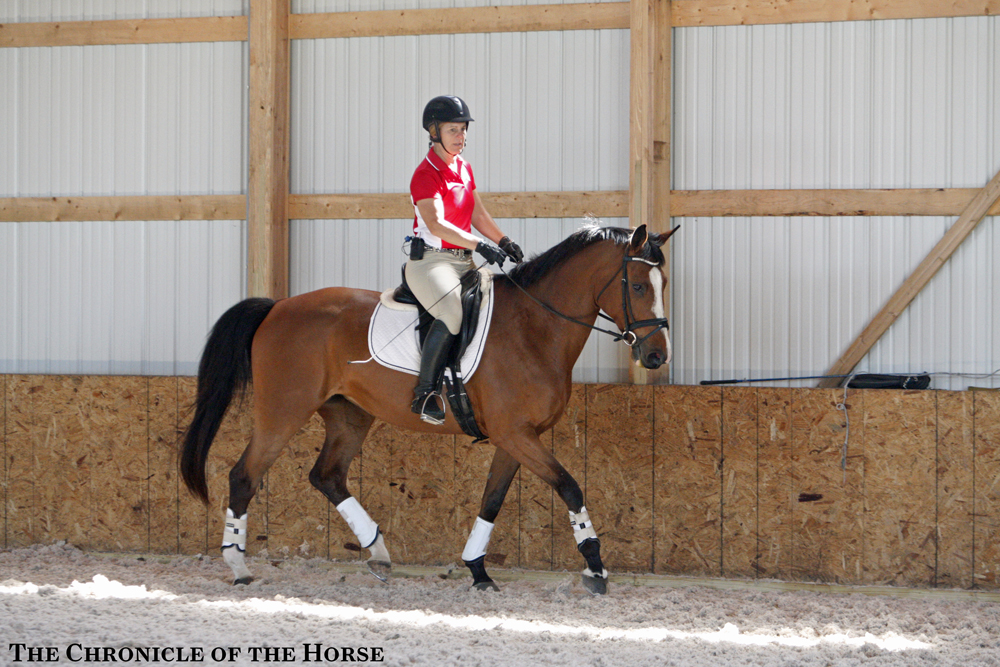
Nancy Elberty on Bella.
“It’s creating an exercise that advocates for footwork. This horse is a little wide behind, so she has to sit down and turn, and she takes that responsibility on herself a little bit, instead of a rider sitting up there going in a straight line going come on, we’ve got to move your feet, move your feet,” Halpin said. “You make it about something.”
Halpin motioned out the door of the indoor at Antebellum farm, where some horses were trotting around the field. “You know if you watch them in the field or whatever, like these ones, they’re spinning and moving their feet all over the place,” Halpin said. “They just needs something to motivate them, and those turns they can understand. They don’t get mad at the bit, because they understand you’re turning them. That’s a direction—you’re not just trying to keep their head down or anything.”
An exercise for true straightness
ADVERTISEMENT
With all of her dressage students, Halpin insisted on truly straight horses. She directed them to borrow a page from the cowboy’s book and think of using a little neck rein to straighten out a horse that is over-bending to the inside.
“A lot of times when people think bend, they turn their [horse’s] head,” Halpin said, turning her own head and throwing her shoulder out. “And when you turn their head, their neck just goes out that way. So what I was saying, like for [Laura Werner and High Hopes], she doesn’t need to slow down, and she doesn’t need to speed up, and she doesn’t need to turn left, she needed to keep the horse straight.
“So literally using a little bit of neck rein, because indirect rein doesn’t work and pulling isn’t going to work, because the horse doesn’t really understand the contact. She’s already got her leg on trying to keep him straight, so basically just guiding him to be straight with a little neck rein.”
How Halpin sees a distance
Halpin took a break during her training level group’s jumping session to explain to the riders how she thinks about related distances and seeing her spot.
“I like to always relate to my distance from four strides away, because that’s when my eye starts to kick in,” Halpin said. “So this line is a five-stride, so I would land and I would count one, one, two, three, four. It may not work for you, but it works for me, all of my girls do it.
“And then when you always relate from four strides out when you’re in a line, then when you’re coming to a single fence you’ll have an idea when you’re four strides out,” Halpin continued.
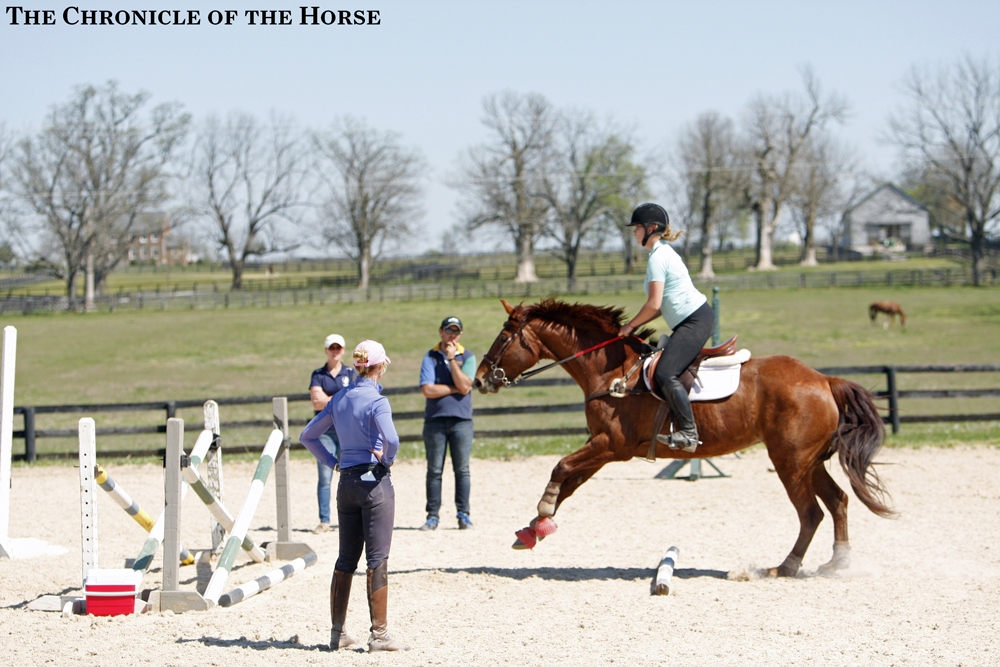
Daina Kaugars and Re D’Feined working with a placing pole exercise.
How Halpin warms up at the show
There was a lesson to be learned in this bit of Halpin horse show advice for trainers and students alike looking to improve their warm-up routines.
“I try to only jump five or six jumps in the warm up before I go, because you think however many clear jumps you get in the warm-up, you’re going to start losing clear jumps in the ring,” Halpin said. “Some horses it’s good to start on the cross-rail to get their footwork sharp, but for some riders the cross rail is not helpful. Just because it’s set doesn’t mean we should jump it. Some riders have a really hard time seeing their spot to a cross-rail.
“But the warm-up is also for the rider, and with some of my riders I just have to tell them OK, go jump five jumps, I’m not going to watch, because they’re going to miss and have issues,” Halpin said with a laugh. “So I say just canter it out, jump five jumps and then we’ll start the warm-up.”
For the greenie lacking confidence over fences
Syrina Lounsberry took both a dressage lesson and a jumping lesson aboard her mare, Crisp, and Halpin gave her some homework.
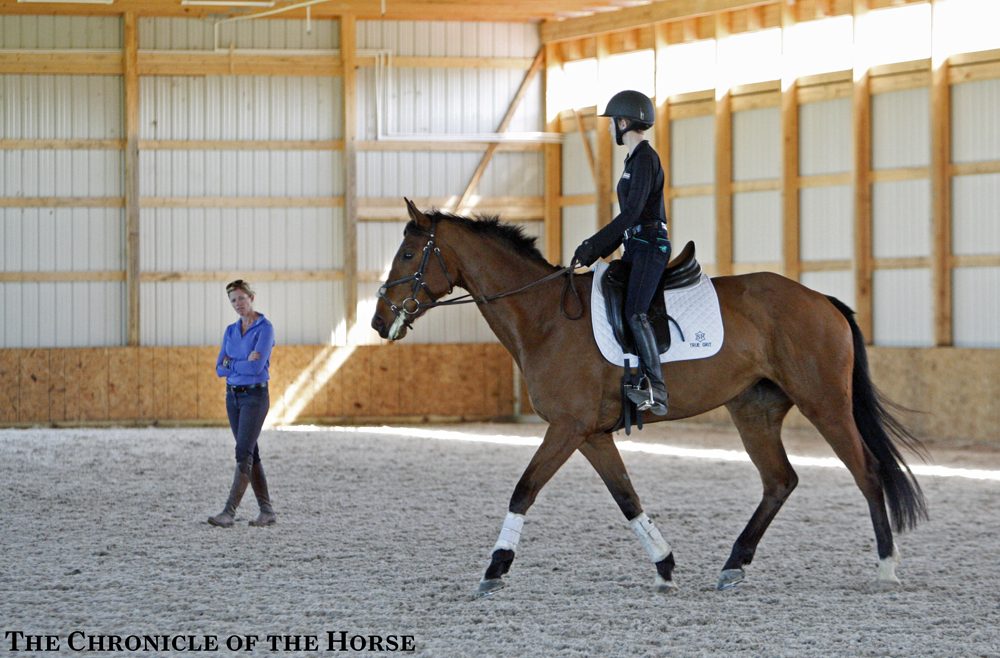
Syrina Lounsberry on Crisp.
“She just needs to kind of trot everything,” Halpin said. “That horse is a green horse, and it’s a green rider. I worked with the horse in here [on the flat] today and it’s actually a really attractive horse, but it’s just been I would say probably a little over-faced, both the kid and the horse. So that’s why when we started taking the course apart and circling and what not, it got a little bit better.”
Once Lounsberry started trying to put the whole course together, however, the mare got nervous and stopped a few times. When this would happen, Halpin would drop one side of the rail on the fence and have Lounsberry trot confidently up and over it.
“When I had her just come canter to a fence, you could see the anxiety in the horse and the rider, so she just needs to come back and trot fences and trot fences until you’re not worried about it anymore,” Halpin said. “The horse needs to trot fences until it realizes it doesn’t need speed to get something done; they can just figure it out as you go.”
Legging up a shorter strided horse
Maggie Perkins rode her chestnut mare Foxy Balboa in the novice jumping group. Like Lounsberry’s horse, Perkins’ mount also struggled with a few refusals in the coursework, though her issues stemmed from a different source. Foxy Balboa was a little sticky off the ground to the jumps, and a little quiet and behind Perkins’ leg.
ADVERTISEMENT
“Yes it’s a chestnut mare, but the mare’s not wanting to go forward is coming from a genuine place,” Halpin said. “She’s short-backed and she’s not the rangiest horse, so there’s some limit in her stride length, and there’s some limit in her range.
“The [rider], when she felt like she was behind the leg, she was kicking her, and ended up trying to kick her a little bit longer. The horse was like ‘This is as long as I get,’” Halpin continued. “So she was like ‘I’m not going any more.’
“So that was the whole conversation, that when she starts feeling like the horse’s canter is not in front of her, she needs to actually put it together, put it rounder, and go forward. Because with a horse that’s a little backwards thinking, you have to put your leg on in a place where they can go forward,” Halpin continued. “If you’re already kind of at the length of the horse and you put your leg on, and they can’t go forward anymore, they’re just going to go backwards.
“So working on more positioning where she could put her leg on and the horse could move off of it, doing that from a place where she’s collected as opposed to a place where the horse is already strung out. That horse needs to get better off the leg, for sure, but the time to train it is not when its like that.”
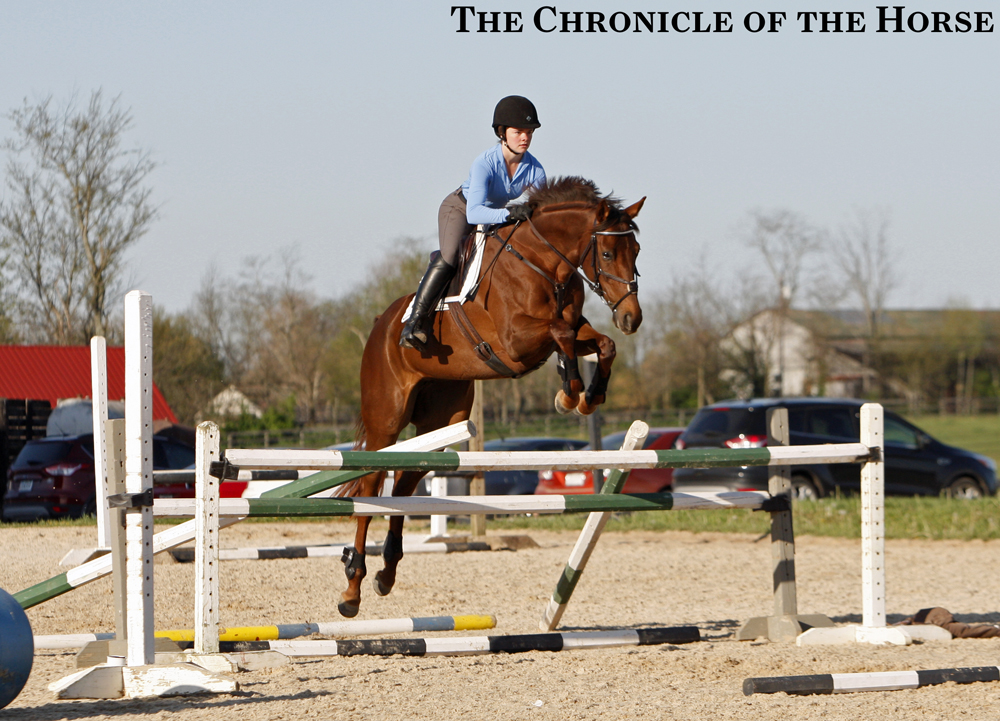
Maggie Perkins on Foxy Balboa.
Using the leg to support at spooky stuff
Carleigh Fedorka rode her Thoroughbred gelding Called To Serve in the novice jumping group (Fedorka and Called To Serve won the dressage competition in by the Retired Racehorse Project Thoroughbred Makeover in 2015), and also struggled with getting her horse over different new and scary obstacles.
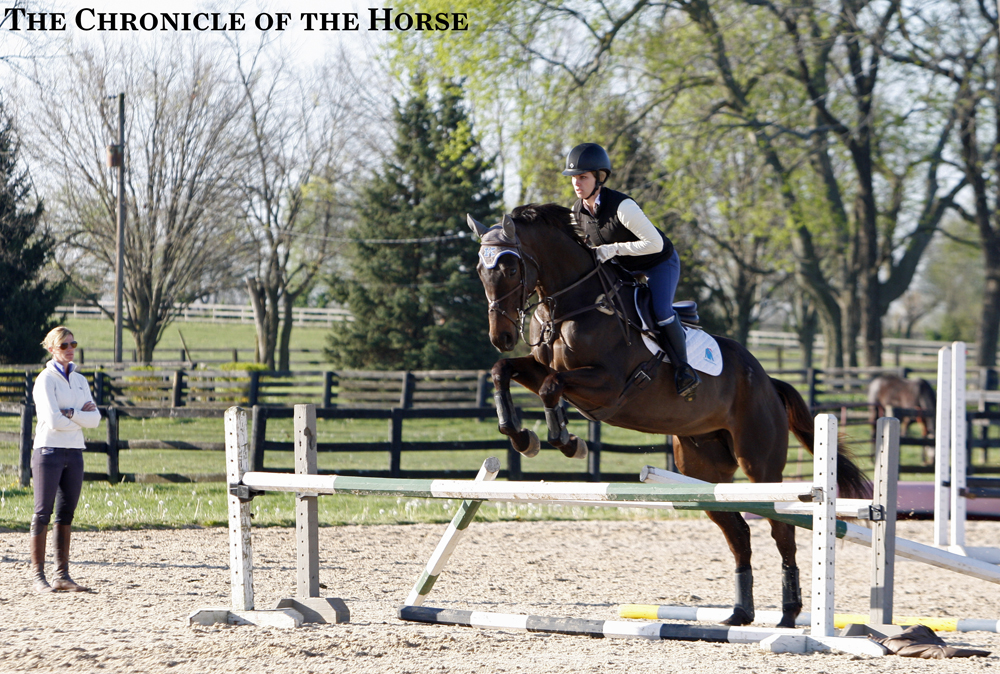
Called To Serve and Carleigh Fedorka.
Halpin explained the importance of that moment when a green or relatively inexperienced horse peeks at something out of the ordinary and how the rider reacts to it.
“It looked to me when that horse saw something that it wasn’t quite sure about, she would end up on a little bit of a short rein, and then she felt like she needed to push it through that moment,” Halpin said.
“I actually think it needs the opposite, to only jump things that you feel comfortable with jumping with a loose rein, and keeping your leg off and letting him think about it. Because that horse, as soon as you put your leg on in stressful situation, it would stop. So you want to just trot around until the situations don’t become stressful, and then teach it enough about the leg that the leg is a supporting aid, not something to force him into something.”
What to do when the fences get bigger and the questions get tougher
With her training level jumping group, Halpin set a big oxer with guide rails right up the center of the ring. On the front side of the oxer, she placed a take-off rail and a ground pole four strides out. Riders took turns cantering up the exercise off both leads, many having issues moving up too much to the jump in the four strides after the rail.
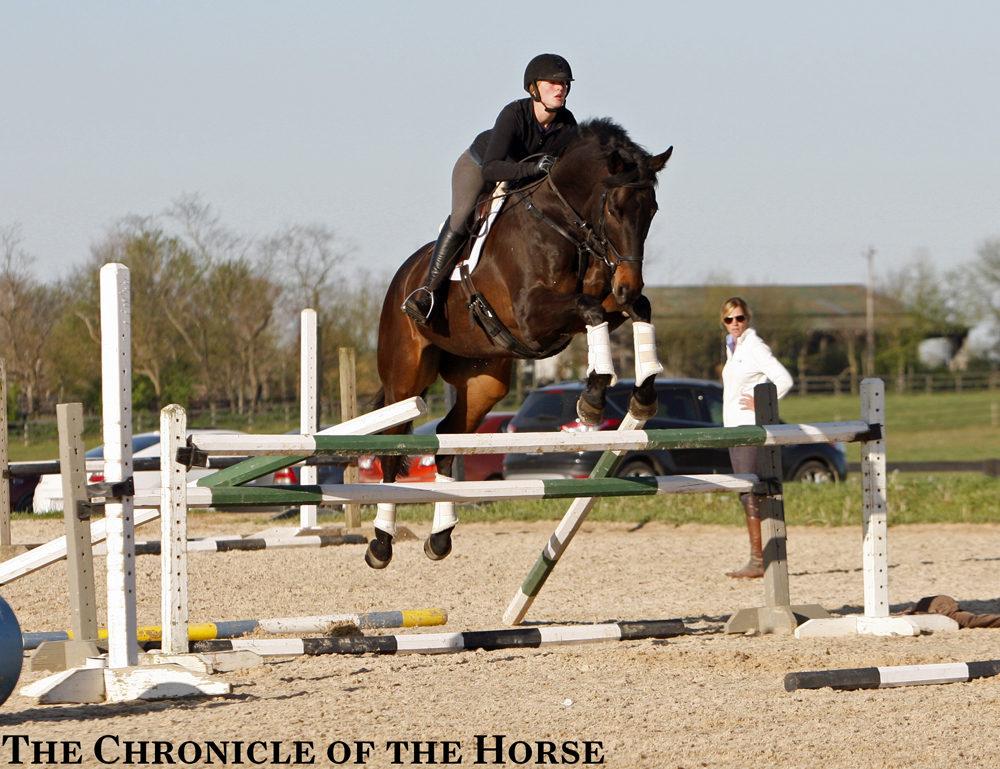
Heather Thomas on Rooster jumping the oxer with guiderails exercise.
Halpin had everyone stop so she could explain the purpose of the exercise.
“Whenever we start adding some height or some difficulty, maybe the water or a big square oxer, or anything like that, you want to think that it always comes from a very positive little packaged, quiet place, and then you move,” Halpin said. “So it depends what level of RPMs you need in that quiet moment, depending on what the thing is, depending on how scared they are of the thing.
“If it’s just a small up bank, and you’re not that worried about it, you don’t want to go galloping across the field and never set up,” Halpin continued. “You just want to slow down for a second and let them pop over it. If it’s a water jump and they’re scared of the water, on the way to it you’re going to send them bring them back, send them bring them back, and as you come around the turn, you’re going to put your thumb on those RPMs, but it’s still going to be coming from a quiet place.”
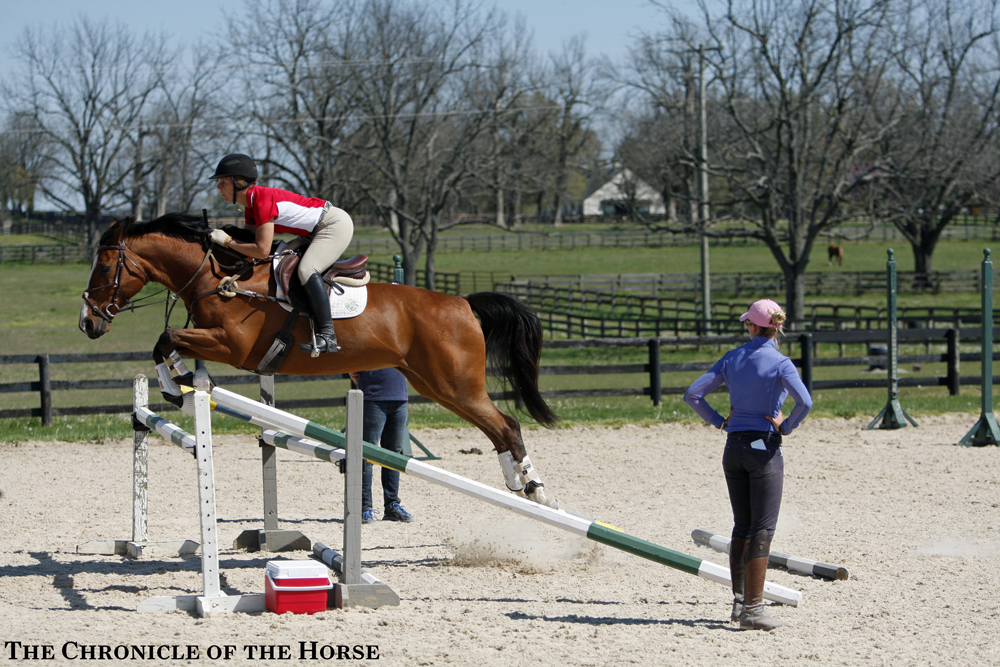
Nancy Elberty on Bella over the oxer exercise.















